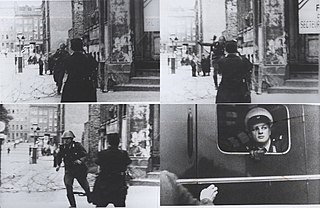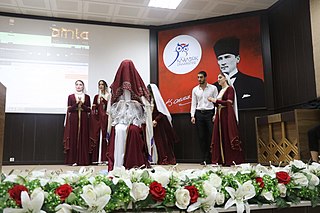Related Research Articles
The United Nations High Commissioner for Refugees (UNHCR) is a United Nations agency mandated to aid and protect refugees, forcibly displaced communities, and stateless people, and to assist in their voluntary repatriation, local integration or resettlement to a third country. It is headquartered in Geneva, Switzerland, with over 18,879 staff working in 138 countries as of 2020.

A refugee, conventionally speaking, is a person who has lost the protection of their country of origin and who cannot or is unwilling to return there due to well-founded fear of persecution. Such a person may be called an asylum seeker until granted refugee status by the contracting state or the United Nations High Commissioner for Refugees (UNHCR) if they formally make a claim for asylum.

The Fergana Valley in Central Asia lies mainly in eastern Uzbekistan, but also extends into southern Kyrgyzstan and northern Tajikistan.

Meskhetian Turks, also referred to as Turkish Meskhetians, Ahiska Turks, and Turkish Ahiskans, are a subgroup of ethnic Turkish people formerly inhabiting the Meskheti region of Georgia, along the border with Turkey. The Turkish presence in Meskheti began with the Ottoman military expedition of 1578, although Turkic tribes had settled in the region as early as the eleventh and twelfth centuries.

Meskheti or Samtskhe, is a mountainous area in southwestern Georgia.

Turkish people or Turks are the largest Turkic people who speak various dialects of the Turkish language and form a majority in Turkey and Northern Cyprus. In addition, centuries-old ethnic Turkish communities still live across other former territories of the Ottoman Empire. Article 66 of the Turkish Constitution defines a Turk as anyone who is a citizen of Turkey. While the legal use of the term Turkish as it pertains to a citizen of Turkey is different from the term's ethnic definition, the majority of the Turkish population are of Turkish ethnicity. The vast majority of Turks are Muslims and follow the Sunni and Alevi faith.
Turks in Azerbaijan, or Turkish Azerbaijanis, refers to ethnic Turkish people who live in the Republic of Azerbaijan. The community is largely made of Ottoman Turkish descendants who have lived in Azerbaijan for centuries, as well as the Turkish Meskhetian community which arrived in large numbers during Soviet rule. More recently, there has been Turkish migration from the Republic of Turkey, as well as from other post-Ottoman modern nation-states and from the Turkish diaspora.
Since the late 1970s until the present, Iraq has witnessed numerous waves of refugees and emigrants due to significant events in its modern history. These events have led to the displacement of millions of Iraqis. These include over three decades of repression, periodic violent attacks, and massacres targeting the Kurdish population in the north and the Shi'a in the south, all carried out by Saddam Hussein's regime. Other factors include the Iran-Iraq War (1980-1988), the Gulf War of 1991, the prolonged economic sanctions until the overthrow of Saddam Hussein, and the 2003 US-led invasion of Iraq.
The Osh riots were an ethnic conflict between Kyrgyz and Uzbeks that took place in June 1990 in the cities of Osh and Uzgen, part of the Kirghiz SSR. The immediate cause of the riots was a dispute between an Uzbek nationalist group Adolat and a Kyrgyz nationalist group Osh Aymaghi over the land of a former collective farm. While official estimates of the death toll range from over 300 to more than 600, unofficial figures range up to more than 1,000. The riots have been seen as a forerunner to the 2010 ethnic clashes in the same region.
Turks in Uzbekistan are ethnic Turks who live in Uzbekistan.
Turks in the former Soviet Union were a relatively small minority within the Soviet Union when excluding Turks of Azerbaijan, Oguz Turks and other Turkish groups. However, their presence is considered important within Turkology due to the deportation of thousands of Turks from their home countries. Under the Ottoman Empire, Samtskhe-Javakheti was heavily Islamised producing a Turkish ethnicity within the southwestern region of Georgia. In November 1944, up to 120,000 of these Turks were deported to Central Asia under the rule of Joseph Stalin.
Azerbaijan has a large number of internally displaced people and refugees, mostly as a result of the Nagorno-Karabakh conflict. The First Nagorno-Karabakh war led to the displacement of approximately 700,000 Azerbaijanis. This figure includes around 500,000 people from Nagorno-Karabakh and the previously occupied surrounding regions, in addition to 186,000 from Armenia.

Sudanese refugees in Israel refers to citizens of Sudan who have sought refuge in Israel due to military conflict at home, and to those who moved there illegally as migrant workers. In 2008, there were 4,000 Sudanese in Israel, 1,200 from Darfur and the remainder Christians from South Sudan. The majority entered through the Israeli-Egypt border. Most live in Tel Aviv, Arad, Eilat and Bnei Brak.
The problem of Kurdish refugees and displaced people arose in the 20th century in the Middle East, and continues today. The Kurds, are an ethnic group in Western Asia, mostly inhabiting a region known as Kurdistan, which includes adjacent parts of Iran, Iraq, Syria, and Turkey.
A refugee crisis can refer to difficulties and dangerous situations in the reception of large groups of forcibly displaced persons. These could be either internally displaced, refugees, asylum seekers or any other huge groups of migrants.
The Mustapha Mahmoud Park Massacre denotes a 2005 incident in Cairo, in which dozens of Sudanese asylum seekers were killed. The civil wars in Sudan that have been taking place on and off since 1955, the subsequent destabilization and economic collapse caused by the country's infrastructure and economy, and the fighting in Darfur (2003), forced millions of Sudanese civilians to flee their homes and cities. Many of them arrived in Egypt, the neighboring country.
Refugees in Poland were, until 2022, a relatively small group. Since 1989, the number of people applying for refugee status in Poland has risen from about 1,000 to 10,000 each year; about 1–2% of the applications were approved. The majority of applications were citizens of the former Soviet Union.
Russian Afghans are Russian citizens and non-citizen residents born in, or with ancestors from, Afghanistan living in Russia and the second largest Afghan community in Europe is part of the Afghan diaspora. A third of the population live in Moscow and the largest community is found around the Sevastopol Hotel, which is home to thousands of Afghan residents and many Afghan-run businesses. In 2007 UNHCR reported many, including children of officials who worked for the pro-Soviet government in Kabul during the 1980s, have failed to gain refugee status. Refugee status approval rate had been between 2% and 5% and about 30% for temporary asylum applications. Many Afghans had entered Russia through Uzbekistan and Tajikistan and were blocked from making refugee application under the “safe third country” rule. Between 1997 and end of 2007, only 844 Afghans were granted refugee status in Russia. Between 2002 and 2007, only 548 Afghans were voluntarily repatriated from Russia with the help of UNHCR.

The deportation of the Meskhetian Turks was the forced transfer by the Soviet government of the entire Meskhetian Turk population from the Meskheti region of the Georgian Soviet Socialist Republic to Central Asia on 14 November 1944. During the deportation, between 92,307 and 94,955 Meskhetian Turks were forcibly removed from 212 villages. They were packed into cattle wagons and mostly sent to the Uzbek Soviet Socialist Republic. Members of other ethnic groups were also deported during the operation, including Kurds and Hemshins, bringing the total to approximately 115,000 evicted people. They were placed in special settlements where they were assigned to forced labor. The deportation and harsh conditions in exile caused between 12,589 to 50,000 deaths.
Isgender Aznaurov is a National Hero of Azerbaijan, and the warrior of the First Nagorno-Karabakh War.
References
- 1 2 3 "POPULATION TRANSFER: The Tragedy of the Meskhetian Turks". Cultural Survival. March 1992.
- 1 2 Pravda 14 October 1989, p.2
- 1 2 Patrick Sullivan (2017). Economic Inequality, Neoliberalism, and the American Community College. p. 79.
- 1 2 UNHCR 1999b , 20.
- ↑ UNHCR 1999b , 21.